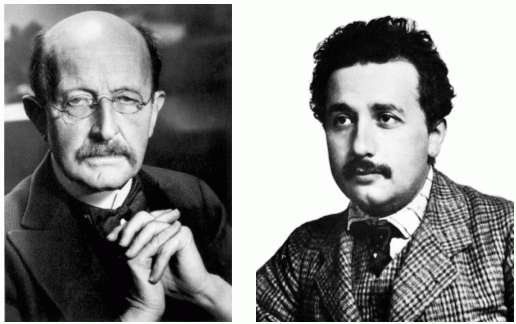Photoelectric effect
Introduction
In the beginnig of 20th century, almost all physical phenomenon, which were known in that time, were successfully explained, except two phenomenon:
- blackbody radiation,
- photoelectric effect
| Ef = h·f , | (1) |

|
| Fig. 1: Max Planck (left) and young Albert Einstein (right) |
The second phenomenon, outer photoeffect, was in 1887 . When a plate of metal is illuminated, in certain conditions there occurs measureable elektric current. In 1888 it was clear, that this photocurrent was induced by negatively charged particles. Those particles were later identified as electrons, which were discovered in 1897 by J. J. Thompson.
Nature of outer photoelectric effect, that is electrons are emitted from metal by its enlightening, was accepted with understanding. But there were some remarkable properties of photocurrent:
- Outer photoeletric effect occured only and if only the frequency of light was higher than certain minimal frequency fm. Value of minimal frequency depends on material type. Existence of this minimal frequency was a mystery.
- Photoelectric effect was not induced in lower frequencies by higher light intensity. So the classical imagination, that energy of light is proportional to its intensity, failed.
Despite classical explanations failed and new properties were mysterious, the phenomenon was successfully explained by Albert Einstein in 1905, for which he won the Nobel prize in 1921. By that time there were found many applications for photoeffect in science and many other fields (e.g. photocell).
You have an opportunity to experience beginning of quantum physics, follow the paths of famous physicist and relive the birth of new modern field.
